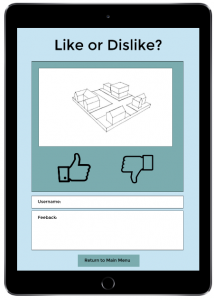This week we were really excited to showcase our prototype to our user clients. The first user test took place on the 8th December at the planning studios in Claremont. We received a lot of critical feedback that we hope to implement into our prototype. This was with the Youth Council who we can proudly quote “would play with the app” after a few refinements. It’s really eye opening to have these informal conversations about the app as the youth council have reasonable and well thought ideas to further our app.

These include the rating systems for our leader board. We have a feedback box where users can state what they like or dislike about the design. However the youth council suggested we make it so other users can read each other comments to generate an interactive conversation between users. Another idea that came up was once the user had completed the design of the development they would then be able to place it into a geolocation. Such as placing the design in google earth or maps to show how their design would look in context. This would make their designs feel more personal and gives them a visual to see how their design would fit in and interact with the surroundings.
The second user test took place at the North Tyneside Council. This gave us an insight to how the planners and developers would use the app to open up conversations between them and the youth. We learnt that planners go into schools to give talks about planning to raise an awareness of planning issues. We questioned whether our app could be used for the youth to help provide an input in actual planning applications but were sadly informed that it wasn’t feasible. However by introducing our app Plan-A-Lot to the school children it allows both parties to have more open conversations and provides a more interactive experience. We hope it provides the missing connection between the youth, planners and developers.
From the user tests we gained quite a lot of advice and suggestions which we plan to take on board. Some will be ideas for future development of the app and other ideas will be idea’s we can incorporate now.